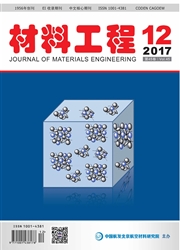

 中文摘要:
中文摘要:
利用金相显微镜,扫描电镜和透射电镜并结合体视学基本原理,对在不同固溶温度和冷却方式(空冷和炉冷)下热等静压(HIP)态FGH96合金中碳化物的数量、空间分布及尺寸分布等进行了定量表征和对比研究。结果表明:HIP态FGH96合金中碳化物主要为富Nb和Ti的MC,在原始颗粒边界(PPB)上分布的碳化物主要为块状,在PPB区域以外分布的碳化物主要由块状和花状MC组成。在1180℃以下进行固溶热处理时,碳化物含量增加并且加剧了合金中的PPB;当固溶温度达到1180℃以上时,随着固溶温度的升高,合金中碳化物数量减少,PPB逐渐消失。1200℃固溶后炉冷,固溶在基体中的碳主要以非PPB碳化物形式重新析出,会导致合金中PPB碳化物数量的降低,即使合金中的碳化物总量与固溶热处理前几乎相同。另外,空冷合金中PPB碳化物尺寸为单峰分布,而炉冷合金中则表现为双峰,后者与炉冷过程中碳化物能够重新析出密切相关。
 英文摘要:
英文摘要:
The OM, SEM, TEM and the stereology method were used to observe and quantitatively characterize the carbides in HIPed FGH96 alloys before and after high temperature solution treatment at different temperature. The results show that the carbides in HIPed FGH96 alloy are mainly MC type carbides which are rich in Ti and Nb. The shape of PPB carbides was block, while the non-PPB carbides were petal and block. Compared with the HIPed alloy, the amount of PPB carbides as well as the total carbides in FGH96 alloy increased when the heat treatment temperature was below 1180℃. But the amount of carbides decreased and the PPB gradually disappeared with the increasing tempera- ture when the heat treatment temperature was above 1180℃. The carbides precipitated mainly as non- PPB carbides if the HIPed alloy was furnace cooled. However, such re-precipitation was suppressed when the alloy was air cooled from the heat treatment temperature. Thus, when the alloy was either furnace or air cooled, the amount of PPB carbides was significantly reduced even the total amount of carbides retains almost the same as that in the HIPed alloy in case of furnace cooling. Moreover, the PPB carbide size distribution in the air cooling alloy appears a unimodal mode, while that in the fur-nace cooling alloy is a bimodal one, the latter of which was resulted from the re-precipitation of car- bides occurred in the furnace cooling process.
 同期刊论文项目
同期刊论文项目
 同项目期刊论文
同项目期刊论文
 期刊信息
期刊信息
